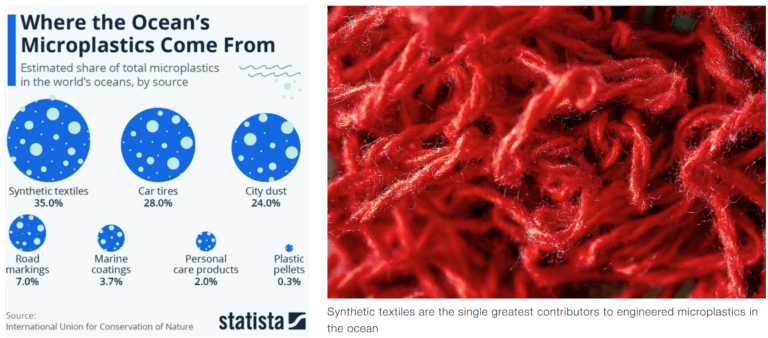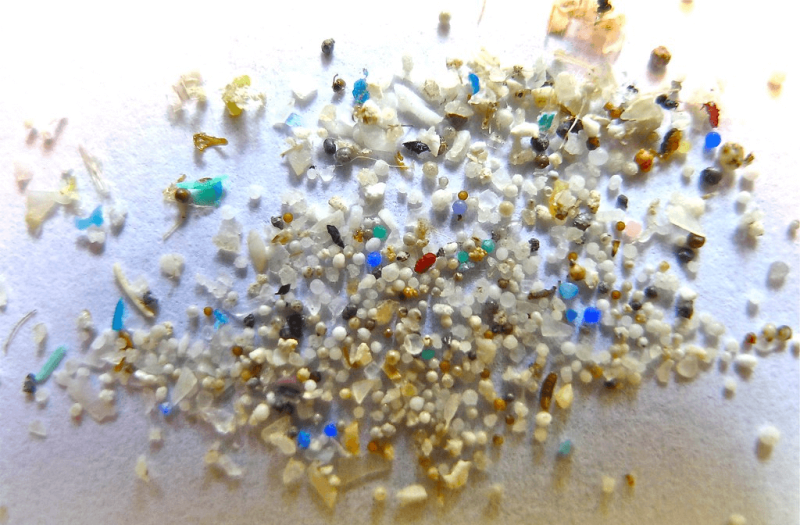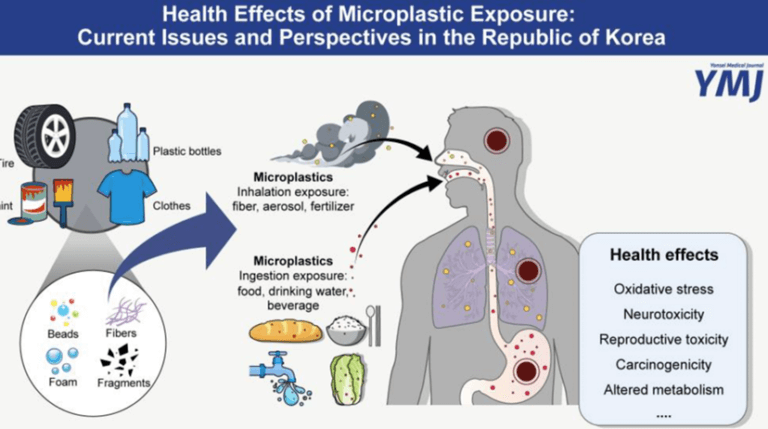Microscopic fibers with massive implications
Microplastic particles measure less than 5mm in size, or smaller than the width of a pencil eraser.
 How do these plastics find their way inside us? I’ve never been caught in a hailstorm of plastic beads (and you probably haven’t either). Unfortunately, what we’re talking about here is something smaller…way smaller.
How do these plastics find their way inside us? I’ve never been caught in a hailstorm of plastic beads (and you probably haven’t either). Unfortunately, what we’re talking about here is something smaller…way smaller.
We’re talking about nanoplastics. Fibers that are smaller than 1 micrometer (1 μm), or the length of a tiny bacterium, or 1/50 the width of a strand of human hair.
Despite its seemingly inconsequential size, nanoplastics pose significant risks.
These barely detectable yet ever-present fibers can pass through biological barriers, like blood and organ lining and, over time, accumulate within the body.
Where do the fibers come from?
 Microplastics, including nanoplastics, are ubiquitous because they’re durable and resist decomposition. They are primarily generated through the breakdown of oversized plastic items and fabrics, microbeads in personal care products, and a host of other industrial processes.
Microplastics, including nanoplastics, are ubiquitous because they’re durable and resist decomposition. They are primarily generated through the breakdown of oversized plastic items and fabrics, microbeads in personal care products, and a host of other industrial processes.
The Organization for Economic Cooperation and Development (OECD) held a seminar based on reporting from the government of Sweden that found synthetic textiles as the single greatest contributor to engineered microplastics in the ocean, accounting for 35% of total microplastic volume.
Polyester, nylon, and acrylic – common fabrics used to make 60% of the world’s clothes — are all considered synthetic.
Unfortunately, our typical shopping habits are mostly to blame here, with synthetic fabrics and toiletries making up almost 40% of the total microplastic volume.
These plastic-based fibers shed microplastics every step along the way, from its production, to wearing and laundering, and even during its eventual disposal, mostly in landfills. In fact, a 2016 study found that each laundering of a fleece jacket releases an average of 1.7 grams of microfibers, which can end up in the ocean. Nylon, polyester and acrylic clothes all shed microfibers when washed.

Tires are next in line as significant sources of microplastics, followed by city dust. While you’ll find a greater concentration of microplastics around densely populated areas with heavy traffic, industrial activity, and busy commerce, these tiny particulates are adept at world travel.
In fact, scientists recorded 365 microplastic particles per square meter falling daily from the sky in the remote Pyrenees Mountains in southern France.
The path from environment to food
One of the most alarming aspects of microplastic contamination is its presence in what we eat. Microplastics have been found in a wide range of whole foods, including seafood, fruits, vegetables, honey, and bottled drinking water.
Microplastic entry into our food system mostly happens through these channels:
- Ingestion by animals and seafood that we eventually eat (“trophic transfer”)
- Soil and plants absorbing degraded fibers from synthetic mulches and films (plastic bags, for example)
- Airborne fibers that, once settled, are ingested or absorbed by trophic transfer
- Food processing and packaging along all points, from the industrial food and drink facilities, to chopping on our polyethylene cutting boards at home
Health risks from ingesting plastics
Several studies have pointed out the adverse effects in various parts of our bodies, including:
- Gastrointestinal absorption: Some studies suggest that microplastics may be absorbed through the gastrointestinal tract and enter our bloodstream, raising concerns about systemic effects on human health as they’re broken down further into nanoparticles that can permeate organ linings.
- Accumulation of toxic substances: Microplastics can act as carriers for harmful chemicals and pollutants, like bisphenol-A (otherwise known as BPA), phthalates, and heavy metals. When ingested, they may release these toxins into our bodies.
- Inflammatory responses: Microplastics may induce systemic inflammatory responses contributing to immune deficiencies, oxidative stress, cell and tissue damage, gastrointestinal disorders, respiratory and cardiovascular diseases
- Endocrine and reproductive disruption: Some microplastics contain additives that can disrupt our endocrine system, potentially leading to hormonal imbalances, reproductive issues, and other associated health risks
“Our research shows that we are ingesting microplastics at the levels consistent with harmful effects on cells, which are in many cases the initiating event for health effects.”
– Evangelos Danopoulos, Hull York Medical School, U.K.
Microplastic release using microwaves
A recent and particularly frightening study from University of Nebraska demonstrates microwaving’s effect on plastics, compounding concerns found in previous studies.
The issue comes down to the structure of plastic during production. Simply put, particles look and behave like cooked spaghetti. You know how cooked spaghetti clumps together when cooling down, but then starts releasing strands when reheated? Those little spaghetti-like plastic structures are released into our foods when plastic gets hot in the same way.
But what about plastic containers that read “microwave-safe”? Perhaps they’re not so safe after all. This study found that heat from the microwave can cause plastic containers to break down, releasing small plastic particles into the food or beverage being heated. And not just a few particles: some containers could release as many as 4 million microplastic and 2 billion nanoplastic particles from only one square centimeter of plastic area within three minutes of microwave heating.

But it doesn’t stop at microwaves:
- Cooking food in plastic containers or using plastic utensils in hot foods can also release microplastics and nanoplastics
- Refrigeration and room-temperature storage for over six months can also release millions to billions of microplastics and nanoplastics
- Polyethylene food pouches commonly used for kids’ applesauce, yogurts, and smoothies, released more particles than polypropylene plastics, often used for refrigerated storage containers and restaurant take-out orders
Separately, the researchers also found that microplastics released from plastic containers caused the death of 77% of human embryonic kidney cells. However, more research needs to be done on this to be conclusive, as this was a first-time in-vitro (i.e. test tube) study.
What can we do?
Yes, this information is scary, but don’t fear…we have an incredible food system providing us all with fresh and affordable food choices every day. And plastics do have their place in this system: they reduce food waste by keeping items fresher longer, avoiding cross contamination, and keeping food prices low.
The most important thing you can do to help offset plastics’ negative effects? Plain and simple: eat a balanced diet. Consuming a variety of fresh produce, lean proteins, and healthy fats is the most efficient way to promote healthy digestion, flush toxins from organs, boost cellular activity, and initiate an effective immune response. And, coincidentally, fresher food choices usually have less plastic packaging than their shelf-stable counterparts.
And here are some other things to implement into your daily life.
- Avoid microwaving plastic by using microwave-safe glass or ceramic containers instead
- Consider a time-restricted eating schedule that provides your body with a daily rest from digestion so your organs can operate better and with less inflammation
- Eat foods high in antioxidants, chlorella, and selenium. These nutrients bind to toxins for removal from your digestive system.
- Limit premade meals packaged with plastic and that require heating in their container(microwave foods in glass containers instead of plastic ones)
- Curb consumption of bivalves like oysters, clams, and mussels. When eating these shellfish, you also consume their digestive systems, which harbor more plastics than foods from anywhere else.
- Reduce plastic use by selecting safer materials, like glass or stainless steel
- Bring a reusable cup when going to the coffee shop, the gym, work, etc.
- Filter your tap water to reduce your exposure to microplastics. And don’t drink water from plastic water bottles
- Reduce canned food purchases since they have thin plastic linings and hold food for extended periods of time
The bottom line
The pervasive presence of microplastics in our food and their release during heating processes like microwaving are concerning issues that demand immediate attention. While the full extent of the health risks associated with ingesting microplastics is still under investigation, reducing plastic use and practicing safe food handling can help mitigate these risks. As consumers, we must remain vigilant and support ongoing research to fully understand and address the impacts of microplastic contamination on our health and the environment.
Hillary E. Kaufman studied at North Eastern University and manages the Dirt To Dinner website. Follow Hillary on Linkedin
A version of this article was originally posted at Dirt To Dinner and has been reposted here with permission. Any reposting should credit the original author and provide links to both the GLP and the original article. Find Dirt To Dinner on X @Dirt_To_Dinner
































